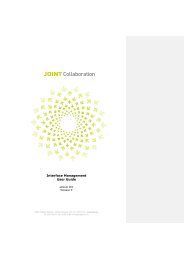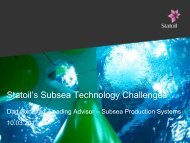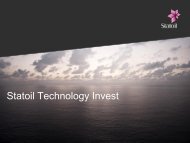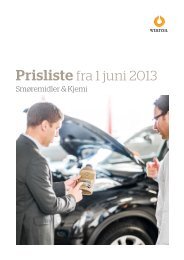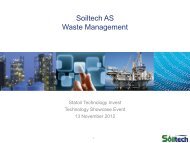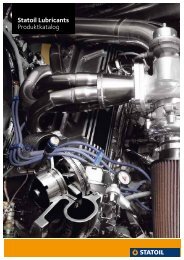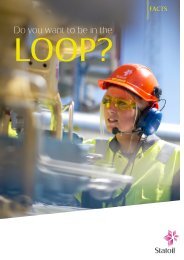Subsea technology questions - Statoil Innovate
Subsea technology questions - Statoil Innovate
Subsea technology questions - Statoil Innovate
Create successful ePaper yourself
Turn your PDF publications into a flip-book with our unique Google optimized e-Paper software.
<strong>Subsea</strong> <strong>technology</strong> <strong>questions</strong>
The challenge:<br />
Installation and maintenance<br />
At 300 meters depth, we have it covered. But at depths up to 3000<br />
meters, the physical conditions demand a radical re-think around<br />
techniques and <strong>technology</strong>.
The challenge:<br />
Installation and maintenance<br />
Lowering a subsea production template to a depth of a few hundred<br />
meters, using cables is a relatively straightforward process. But as the<br />
depth increases, the dynamics change. There comes a point where the<br />
weight of the cable played out exceeds that of the template itself — and it<br />
keeps on increasing, placing enormous stresses on the surface vessel. Is<br />
there an alternative method of installing subsea equipment?<br />
Increased depths present additional challenges for the maintenance of<br />
pipelines and equipment. Would it be possible to employ autonomous<br />
remotely operated vehicles which remain on the seabed and are capable of<br />
operating without the need for an umbilical?<br />
These are just a few of the challenges we face. Any good ideas you might have on<br />
subsea installation and maintenance are welcome.<br />
Take the challenge!
The challenge:<br />
Separation of oil/gas/water and sand!<br />
We've pioneered robust solutions for separating produced oil and<br />
gas from water and sand on the seabed down to 300 meters. But<br />
greater depths require more resilient, compact and cost-effective<br />
solutions.
The challenge:<br />
Separation of oil/gas/water and sand!<br />
We have successfully developed separation facilities which remove the need<br />
to take the produced mixture of oil, gas and water to the surface, and<br />
significantly increase recovery. It works well, but in deeper waters, the<br />
design of the structure simply would not work. There may be other<br />
methods of separation – for example involving centrifugal forces – but how<br />
could these be made to work reliably at depths up to 3000 meters?<br />
We face many challenges. Answers to these, or any other good ideas related to<br />
the separation of oil, gas, water and sand are welcome.<br />
Take the challenge!
The challenge:<br />
Produced water disposal<br />
Water separated from the well-stream can be re-injected. But as the<br />
depth increases so do the physical challenges, as well as the costs.<br />
Is there an alternative to re-injection?
The challenge:<br />
Produced water disposal<br />
The produced mixture from the wellstream can typically comprise of up to<br />
90% water. In the course of extraction, this means dealing with significant<br />
quantities of water. On a platform, water can be treated so that it can be<br />
disposed of at sea, or alternatively produced water can be re-injected into<br />
the well. At greater depths the cost of bringing the produced water up to<br />
the platform with the wellstream increases and the costs involved in drilling<br />
a well for re-injection become prohibitive. Is there a better, more costeffective<br />
way of handling water at these depths?<br />
Your answer to this, or any other good ideas you might have related to produced<br />
water disposal are welcome.<br />
Take the challenge!
The challenge:<br />
Remote monitoring and control<br />
In our industry, knowledge is power. But placing monitoring and<br />
control systems further from command centers brings out a range<br />
of new challenges over reliability and accuracy.
The challenge:<br />
Remote monitoring and control<br />
Temperatures. Flowrates through pipelines. Precise quantities of oil and gas<br />
in the wellstream. These variables, as well as many others, require constant,<br />
accurate monitoring. And yet, at the extremes of the subsea environment,<br />
conventional means of measurement may not always be the most durable.<br />
But what are the alternatives?<br />
The control systems we employ have typically been connected using copper<br />
cable. These are gradually being replaced by fibre optics as a more effective<br />
means of transmission. But there may be other solutions, and the question<br />
of how to power these systems over increasing distances remains.<br />
Do you have any answers to the above, or any other good ideas related to remote<br />
monitoring and control? Please let us know.<br />
Take the challenge!
The challenge:<br />
Long distance power transmission<br />
As tie-backs to infrastructure increase in length, how is it possible<br />
to maintain a consistent, reliable power supply to installations on<br />
the seabed?
The challenge:<br />
Long distance power transmission<br />
Over longer distances, the principal challenge is how to maintain a stable<br />
power supply to the remote production facilities, which in some cases can<br />
be more than 100 km from land.<br />
In addition, to install electrical equipment such as compressors, pumps and<br />
the necessary electrical controls and switchgear at even greater water<br />
depths is to place them in a particularly hostile environment. One solution<br />
has been simply to encase equipment in a pressure chamber. However,<br />
particular challenges remain – not least how to maintain the integrity of the<br />
chamber, and the electrical connections, especially where power cables<br />
penetrate the chamber walls. What are the solutions that will allow electrical<br />
equipment to keep on working at increased depths?<br />
Your answer to this, or any other good ideas you might have regarding long<br />
distance subsea power transmission are welcome.<br />
Take the challenge!
The challenge:<br />
Local power generation and storage<br />
It may be possible to power smaller installations and control<br />
systems using localized sources. But what form could these power<br />
sources take?
The challenge:<br />
Local power generation and storage<br />
To avoid the problems presented by the increasing length of power feeds,<br />
one solution would be to use power generated locally to run equipment on<br />
the sea bed. Known means of generating power could include water<br />
turbines, or windmills on the sea surface. But what are the alternatives?<br />
Also, what is the best way to store energy from these power sources? Are<br />
there batteries that could be used at increased depths? Or systems for<br />
storing energy using a flywheel?<br />
We are open to any ideas related to local power generation and subsea storage.<br />
Take the challenge!
The challenge:<br />
New materials<br />
Working at extremes of pressure and temperature, subjected to<br />
corrosive and abrasive forces, traditional materials rapidly reach<br />
the limits of performance. But what are the materials that can<br />
replace them?
The challenge:<br />
New materials<br />
The environments we work in and the operating conditions we're forced to<br />
deal with place equipment and materials under extreme pressure. Sand<br />
content in the wellstream flowing through pipelines under pressure is<br />
highly abrasive. Sea water and the fluids extracted from subsea wells are<br />
inherently corrosive. Wax and hydrates can form and adhere to pipelines at<br />
low temperatures, causing blockages. In each of these scenarios, and<br />
others, the choice of materials we use could provide a more effective and<br />
durable solution.<br />
But which materials? All good ideas are welcome.<br />
Take the challenge!
<strong>Subsea</strong> <strong>technology</strong> <strong>questions</strong><br />
Sigrun Daireaux<br />
Business Developer<br />
idea@statoil.com<br />
innovate.statoil.com<br />
Thank you.





